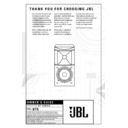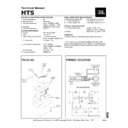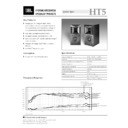JBL HT 5 (serv.man4) User Manual / Operation Manual ▷ View online
S P E A K E R P L A C E M E N T
Proper placement of the
speakers is an important step
in obtaining the most realistic
soundstage possible. These
recommendations are for the
optimum placement of the
speakers is an important step
in obtaining the most realistic
soundstage possible. These
recommendations are for the
optimum placement of the
loudspeakers. Use these
placement recommendations
as a guide. Slight variations
will not diminish your
listening pleasure.
placement recommendations
as a guide. Slight variations
will not diminish your
listening pleasure.
HT5 loudspeakers are video-
shielded and can safely be
placed near a television.
shielded and can safely be
placed near a television.
As Front Speakers
As Surround Speakers
5–6 ft.
HT5
The front speakers should
be placed the same distance
from each other as they are
from the listening position.
They should be placed at
about the same height from
the floor as the listeners’
ears will be, or they may be
angled toward the listeners.
be placed the same distance
from each other as they are
from the listening position.
They should be placed at
about the same height from
the floor as the listeners’
ears will be, or they may be
angled toward the listeners.
If a center-channel speaker
is used, it should be placed
slightly behind the front left
and right speakers, and no
is used, it should be placed
slightly behind the front left
and right speakers, and no
more than two feet above or
below the tweeters of the
left and right speakers. It is
often convenient to set the
center speaker on top of the
television set.
below the tweeters of the
left and right speakers. It is
often convenient to set the
center speaker on top of the
television set.
The two surround speakers
should be placed slightly
behind the listening position
and, ideally, should face
each other and be at a level
higher than the listeners’
ears. If that is not possible,
should be placed slightly
behind the listening position
and, ideally, should face
each other and be at a level
higher than the listeners’
ears. If that is not possible,
they may be placed in the
corners of the room behind
the listening position, angled
in toward the center of the
listening area. The surround
speakers should not call
attention to themselves.
Experiment with their
placement until you hear a
diffuse, ambient sound
accompanying the main-
program material heard in
the front speakers.
corners of the room behind
the listening position, angled
in toward the center of the
listening area. The surround
speakers should not call
attention to themselves.
Experiment with their
placement until you hear a
diffuse, ambient sound
accompanying the main-
program material heard in
the front speakers.
S P E A K E R F E E T
The HT5 comes with rubber,
self-adhesive footpads,
which should be attached to
the bottom corners of each
self-adhesive footpads,
which should be attached to
the bottom corners of each
speaker to protect both
your furniture and the
speakers.
your furniture and the
speakers.
Alternative Surround Speaker
Placement
Placement
If there is no sound from
any of the speakers:
• Check that receiver/
amplifier is on and that
a source is playing.
• Review proper operation
of your receiver/amplifier.
• Check all wires and con-
nections between receiver/
amplifier and speakers.
• Make sure all wires are
connected. Make sure none
of the speaker wires are
frayed, cut or punctured.
any of the speakers:
• Check that receiver/
amplifier is on and that
a source is playing.
• Review proper operation
of your receiver/amplifier.
• Check all wires and con-
nections between receiver/
amplifier and speakers.
• Make sure all wires are
connected. Make sure none
of the speaker wires are
frayed, cut or punctured.
If there is no sound coming
from one speaker:
• Check the “Balance”
control on your receiver/
amplifier.
• Check all wires and
connections between
receiver/amplifier and
speakers. Make sure all
wires are connected. Make
sure none of the speaker
wires are frayed, cut or
punctured.
from one speaker:
• Check the “Balance”
control on your receiver/
amplifier.
• Check all wires and
connections between
receiver/amplifier and
speakers. Make sure all
wires are connected. Make
sure none of the speaker
wires are frayed, cut or
punctured.
• In Dolby* Digital or DTS
®
modes, make sure that the
receiver/processor is
configured so that the
speaker in question is
enabled.
receiver/processor is
configured so that the
speaker in question is
enabled.
If the system plays at low
volumes but shuts off as
volume is increased:
• Check all wires and
connections between
receiver/amplifier and
speakers. Make sure all
wires are connected. Make
sure none of the speaker
wires are frayed, cut or
punctured.
• If more than one pair of
main speakers is being
used, check the minimum
impedance requirements of
your receiver/amplifier.
volumes but shuts off as
volume is increased:
• Check all wires and
connections between
receiver/amplifier and
speakers. Make sure all
wires are connected. Make
sure none of the speaker
wires are frayed, cut or
punctured.
• If more than one pair of
main speakers is being
used, check the minimum
impedance requirements of
your receiver/amplifier.
If there is low (or no) bass
output:
• Make sure the connections
to the left and right “Speaker
output:
• Make sure the connections
to the left and right “Speaker
Inputs” have the correct
polarity (+ and –).
• If a powered subwoofer is
being used, check the
manufacturer’s instructions
for proper use.
• If a subwoofer is being
used in Dolby Digital or DTS
mode, make sure your
receiver/processor is
configured so that the
subwoofer and LFE output
are enabled.
polarity (+ and –).
• If a powered subwoofer is
being used, check the
manufacturer’s instructions
for proper use.
• If a subwoofer is being
used in Dolby Digital or DTS
mode, make sure your
receiver/processor is
configured so that the
subwoofer and LFE output
are enabled.
If there is no sound from
the surround speakers:
• Check all wires and con-
nections between receiver/
amplifier and speakers.
Make sure all wires are
connected. Make sure none
of the speaker wires are
frayed, cut or punctured.
• Review proper operation of
your receiver/amplifier and
its surround-sound features.
• Make sure the movie or TV
show you are watching is
the surround speakers:
• Check all wires and con-
nections between receiver/
amplifier and speakers.
Make sure all wires are
connected. Make sure none
of the speaker wires are
frayed, cut or punctured.
• Review proper operation of
your receiver/amplifier and
its surround-sound features.
• Make sure the movie or TV
show you are watching is
CONNECTION TIPS
S P E A K E R C O N N E C T I O N S
T R O U B L E S H O O T I N G
Speakers and electronics
terminals have corre-
sponding (+) and (–)
terminals. It is important to
connect both speakers
identically: (+) on the
terminals have corre-
sponding (+) and (–)
terminals. It is important to
connect both speakers
identically: (+) on the
speaker to (+) on the
amplifier and (–) on the
speaker to (–) on the
amplifier. Wiring “out of
phase” results in thin sound,
weak bass and a poor
stereo image.
amplifier and (–) on the
speaker to (–) on the
amplifier. Wiring “out of
phase” results in thin sound,
weak bass and a poor
stereo image.
With multichannel surround-
sound systems, connecting
all of the speakers in your
system with the correct
polarity is important in order
to preserve the proper
sound systems, connecting
all of the speakers in your
system with the correct
polarity is important in order
to preserve the proper
ambience and directionality
of the program material.
of the program material.
– +
– +
– +
Speaker Outputs
LEFT
RIGHT
– +
JBL Consumer Products
250 Crossways Park Drive, Woodbury, NY 11797
800-336-4JBL (4525) (USA only)
www.jbl.com
©2000 JBL, Incorporated.
JBL is a registered trademark of JBL, Incorporated.
JBL is a registered trademark of JBL, Incorporated.
Part No. 336349-001
T W E E T E R T Y P E : Pure-titanium dome with Bi-Radial
®
Constant Directivity Horn
D E S I G N G O A L : Bring the thrill of live performance and movie sound to
the home environment by calling on JBL’s professional engineering leadership.
the home environment by calling on JBL’s professional engineering leadership.
C R O S S O V E R N E T W O R K : Straight-Line Signal Path
™
(SSP)
W O O F E R T Y P E : Cast-aluminum basket with HeatScape
™
motor structure
P O R T D E S I G N : FreeFlow
™
flared
P R O F E S S I O N A L R E F E R E N C E : Cinema Loudspeaker Series
O W N E R ’ S G U I D E
P R O S O U N D
C O M E S H O M E
C O M E S H O M E
™
P R O D U C T L I N E :
H T S E R I E S
M O D E L
HT
5
N U M B E R :
S P E C I F I C A T I O N S
HT5
Frequency Response (–6dB):
50Hz – 20kHz
(±2dB):
100Hz – 18kHz
Sensitivity (2.83V/1m):
85dB
Maximum Recommended Amplifier Power**:
130W
Nominal Impedance:
8 Ohms
Crossover Frequency:
2300Hz
Low-Frequency Transducer:
5-1/4"
High-Frequency Transducer:
1" Pure-titanium dome, with Bi-Radial
®
horn
Dimensions (H x W x D):
13-5/8" x 6-13/16" x 10"
346mm x 173mm x 254mm
346mm x 173mm x 254mm
Weight:
14 lb/6.4kg
Occasional refinements may be made to existing products without notice, but will always meet or exceed original specifications
unless otherwise stated.
unless otherwise stated.
* Trademark of Dolby Laboratories. DTS is a registered trademark of Digital Theater Systems, Inc.
** The maximum recommended amplifier power rating will ensure proper system headroom to allow for occasional peaks. We do not
recommend sustained operation at these maximum power levels.
recorded in a surround-
sound mode. If it is not, check
to see if your receiver/
amplifier has other surround
modes you may use.
• In Dolby Digital or DTS
modes, make sure your
receiver/processor is
sound mode. If it is not, check
to see if your receiver/
amplifier has other surround
modes you may use.
• In Dolby Digital or DTS
modes, make sure your
receiver/processor is
configured so that the
surround speakers are
enabled.
• Review the operation of
your DVD player and the
jacket of your DVD to make
sure that the DVD features
the desired Dolby Digital or
surround speakers are
enabled.
• Review the operation of
your DVD player and the
jacket of your DVD to make
sure that the DVD features
the desired Dolby Digital or
DTS mode, and that you
have properly selected that
mode using both the DVD
player’s menu and the DVD
disc’s menu.
have properly selected that
mode using both the DVD
player’s menu and the DVD
disc’s menu.
T R O U B L E S H O O T I N G ( c o n t . )
JBL Consumer Products
250 Crossways Park Drive, Woodbury, NY 11797
800-336-4JBL (4525) (USA only)
www.jbl.com
©2000 JBL, Incorporated.
JBL is a registered trademark of JBL, Incorporated.
JBL is a registered trademark of JBL, Incorporated.
Part No. 336349-001
T W E E T E R T Y P E : Pure-titanium dome with Bi-Radial
®
Constant Directivity Horn
D E S I G N G O A L : Bring the thrill of live performance and movie sound to
the home environment by calling on JBL’s professional engineering leadership.
the home environment by calling on JBL’s professional engineering leadership.
C R O S S O V E R N E T W O R K : Straight-Line Signal Path
™
(SSP)
W O O F E R T Y P E : Cast-aluminum basket with HeatScape
™
motor structure
P O R T D E S I G N : FreeFlow
™
flared
P R O F E S S I O N A L R E F E R E N C E : Cinema Loudspeaker Series
O W N E R ’ S G U I D E
P R O S O U N D
C O M E S H O M E
C O M E S H O M E
™
P R O D U C T L I N E :
H T S E R I E S
M O D E L
HT
5
N U M B E R :
S P E C I F I C A T I O N S
HT5
Frequency Response (–6dB):
50Hz – 20kHz
(±2dB):
100Hz – 18kHz
Sensitivity (2.83V/1m):
85dB
Maximum Recommended Amplifier Power**:
130W
Nominal Impedance:
8 Ohms
Crossover Frequency:
2300Hz
Low-Frequency Transducer:
5-1/4"
High-Frequency Transducer:
1" Pure-titanium dome, with Bi-Radial
®
horn
Dimensions (H x W x D):
13-5/8" x 6-13/16" x 10"
346mm x 173mm x 254mm
346mm x 173mm x 254mm
Weight:
14 lb/6.4kg
Occasional refinements may be made to existing products without notice, but will always meet or exceed original specifications
unless otherwise stated.
unless otherwise stated.
* Trademark of Dolby Laboratories. DTS is a registered trademark of Digital Theater Systems, Inc.
** The maximum recommended amplifier power rating will ensure proper system headroom to allow for occasional peaks. We do not
recommend sustained operation at these maximum power levels.
recorded in a surround-
sound mode. If it is not, check
to see if your receiver/
amplifier has other surround
modes you may use.
• In Dolby Digital or DTS
modes, make sure your
receiver/processor is
sound mode. If it is not, check
to see if your receiver/
amplifier has other surround
modes you may use.
• In Dolby Digital or DTS
modes, make sure your
receiver/processor is
configured so that the
surround speakers are
enabled.
• Review the operation of
your DVD player and the
jacket of your DVD to make
sure that the DVD features
the desired Dolby Digital or
surround speakers are
enabled.
• Review the operation of
your DVD player and the
jacket of your DVD to make
sure that the DVD features
the desired Dolby Digital or
DTS mode, and that you
have properly selected that
mode using both the DVD
player’s menu and the DVD
disc’s menu.
have properly selected that
mode using both the DVD
player’s menu and the DVD
disc’s menu.
T R O U B L E S H O O T I N G ( c o n t . )
Display




